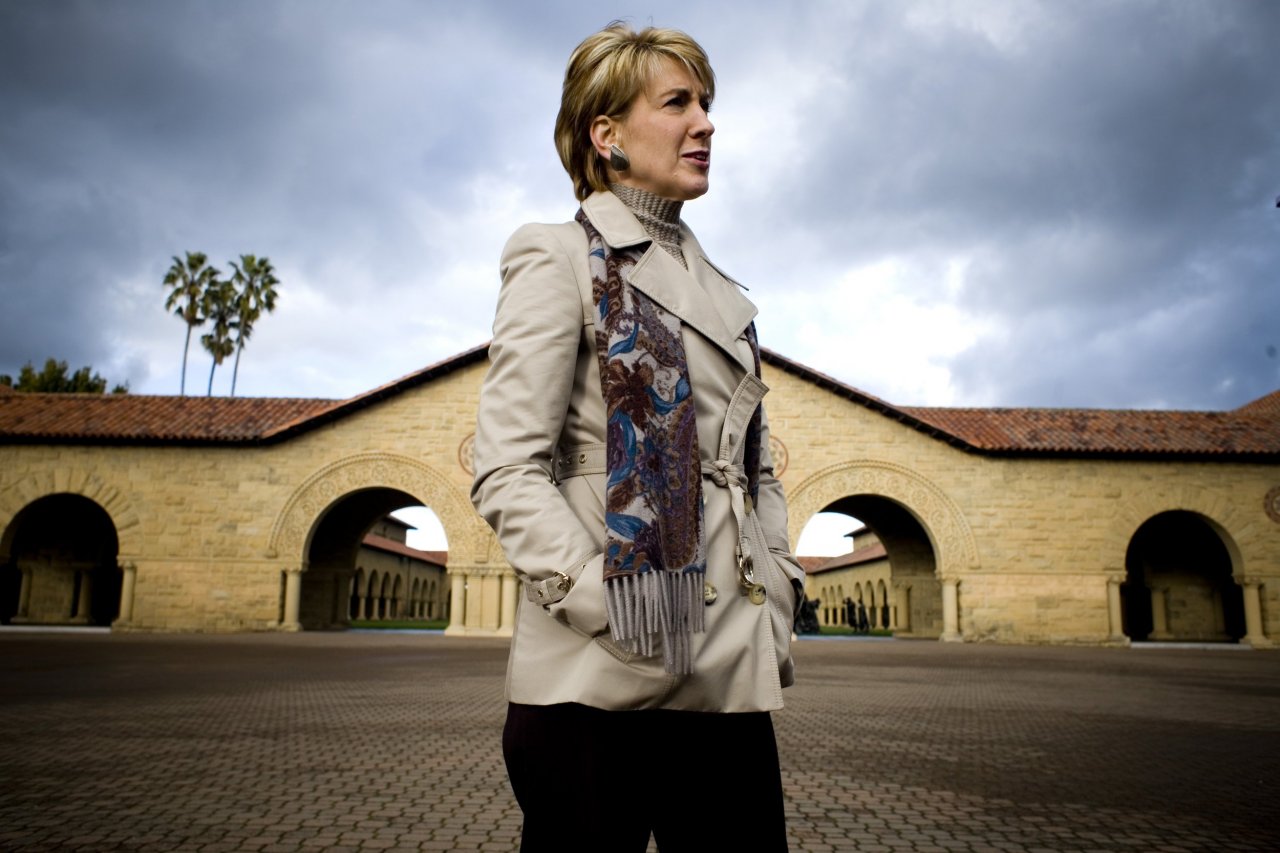No one has ever mistaken Carly Fiorina for Steve Jobs. But was she really a disastrous CEO at Hewlett-Packard, the Palo Alto, California-based global computing and information technology company she led from 1999 to 2005? As she rises in the polls, Fiorina's business record is becoming a bigger target. Donald Trump regularly slams her years running a Fortune 20 company. The New York Times trumpets opinion pieces branding her a failure in that job. The headlines suggest the 61-year-old Republican single-handedly destroyed HP, from which she was fired.
The critics cite her spectacular defenestration and point to undeniably ugly metrics, like HP losing more than half its shareholder value under her, as proof that she was a lousy CEO and would be a disaster as president. They note HP failed repeatedly to meet its own revenue and profit forecasts. Numbers may not lie, but in some cases they don't tell the whole story. And in Fiorina's case, they may be misleading. While her tenure at HP may not have been as successful as Fiorina boasts, it was by no means the horror show her critics portray.
To better understand the subtleties, you have to go back to the late '90s, when Fiorina took command of HP just before the dot-com bust and the September 11 attacks. She was an outsider—its first female chairman and CEO since the company's founding in 1939, and the only one not promoted from inside. She was also eyed skeptically, because her expertise was marketing, not tech. Early in her HP stint, she was treated as a rock star by the business press, with Fortune magazine naming her the No. 1 most powerful woman in business in 1998, then ripping her as a failure just days before her firing.
The two major metrics by which a CEO is often judged are profits and stock price—and those are what her naysayers cite as prima facie evidence that she blew it. With Fiorina at the helm, HP's revenues nearly doubled after she led a merger with competitor Compaq in 2002, but the stock price fell more than 50 percent. Not surprisingly, Fiorina highlights her revenue figures on the stump, while her critics underscore the drop in stock price and profit.
But Fiorina had just one year of actual losses—2002, the year of the Compaq deal—which is not really unusual in the wake of a big merger. And she posted profits every other year she was CEO. In fact, by 2004, two years after the Compaq merger and the year before her ouster, the company's profits grew to exceed premerger levels and were on the upswing, a trend that continued for years after she was ousted. Did the stock prices of similar computer giants like Microsoft, Dell and IBM do better? Yes, but that doesn't make Fiorina a flop.
Fiorina's detractors have been quick to say her revenue figures are irrelevant. They say when you slap two revenue-generating companies together, of course you get more revenue—that, in effect, Fiorina bought HP's growth; she didn't create it. But a survey of 270 mergers across countries and industries published in the Harvard Business Review in 2008 found that Fiorina's focus on revenue over earnings was the correct approach. In fact, their study found that growing revenue, rather than earnings, just after a merger leads to best results.

"After a merger, managers should ignore the usual advice to strive primarily for improving the bottom line through cost reductions," wrote merger experts Jürgen Rothenbuecher and Joerg Schrottke of A.T. Kearney, a global consulting firm. "Instead, they should make it a priority to strengthen sales and marketing in order to sustain profitable revenue growth. That's because revenue growth is necessary for earnings growth, the most reliable engine for driving total shareholder returns over the long term." This is exactly what Fiorina did. The last full year she led HP, it reported " record revenues achieved in every business."
Fiorina has caught flak over another metric—layoffs. HP let go roughly 30,000 employees following the Compaq merger, which was horrible for those tossed on the street but is the kind of ruthless move often necessary for companies to survive and thrive. By contrast, current CEO Meg Whitman, who once ran eBay, has laid off 55,000 people since 2011 and expects to fire more. Under Whitman, HP also reported a loss of more than $12 billion for fiscal year 2012, dwarfing Fiorina's singular loss in fiscal 2002 of slightly less than $1 billion. Whitman, like Fiorina, has been excoriated for her performance by some members of the press, but she defends the layoffs she and Fiorina made at HP. "You have to be competitive—or you will lose," Whitman said during a recent TV interview.
While Fiorina critics note that she failed to execute on strategy and was not a details-oriented manager, they also acknowledge that HP's board of directors was "dysfunctional." That last part is an understatement. Even after HP's board fired Fiorina in 2005, its members distrusted one another so much that the new chairman, Patricia Dunn, launched a secret investigation into the directors' behavior, which included making leaks to the press. That spiraled into a spying scandal that attracted the attention of Congress, the U.S. Federal Trade Commission and the Department of Justice. It resulted in lawsuits, criminal charges, convictions and fines—and Fiorina had nothing to do with it. Some of those board members who supported her abrupt dismissal, like Silicon Valley investment legend Tom Perkins, now say they made a mistake. In an ad he took out in The New York Times this past August, he wrote that while Fiorina lost her job by standing up to the board, "history proves Carly was right."
While CEOs generally don't have a long life expectancy, Fiorina's succeeding CEOs at HP have all been fired or smeared—or both. Whitman, the only other female CEO in the company's history, has been called a failure. Even Mark Hurd, roundly credited with cutting costs and restoring the company's stock price and profitability while CEO from 2005 to 2010, is still plagued by a website called FuckYouMarkHurd.com after being forced out of HP. Hurd is now CEO at Oracle, a global computer technology corporation.
The upshot is clear: There may be horror stories, but the common denominator here is not Fiorina. It's HP.
The biggest concern of some of Fiorina's most vociferous detractors—among them Steven Rattner, former head of the Quadrangle Group, a New York private equity firm, and Jeffrey Sonnenfeld, senior associate dean at the Yale School of Management—is that she has the audacity to run for the nation's highest office based on her track record at HP. For the record, Rattner is a major Democratic donor, while Sonnenfeld is an occasional one.
"Unfortunately, she's tried to shade and nuance the facts," Sonnenfeld tells Newsweek. "Sometimes the truth is not gray, it's black and white." He notes that many ousted CEOs will rebound as a CEO elsewhere—like Hurd, who was scooped up almost immediately. Not so with Fiorina. When asked during a recent TV interview why she never took another job as a CEO, she said, "Because I didn't want to go back to work as a CEO, that's why. Because I had done that." She added that she "was offered many jobs," including as a CEO, but "I wanted a break, and then I wanted to give back."
The gap of 10 years in Fiorina's résumé is an issue for many. At the end of Tough Choices, her 2006 memoir, she described herself as seeking a new kind of life after HP—and she had the money to go do it after a payday of $21 million in cash and additional stock and pension benefits totaling $19 million. So she could afford to write glowingly, "I love to fall asleep at night and awake when I choose…. I love to spend the day, as I am today, in the company of children with nothing particular to do and nowhere particular to go."
Fiorina did work on the presidential campaign of GOP candidate John McCain in 2008, led several charities and chaired an external advisory board from 2008 to 2009 for the CIA, receiving high marks from Michael Hayden, former head of both the CIA and the National Security Agency under George W. Bush. Hayden tells Newsweek he found her "bright, inquisitive" and an honest broker of information. In 2010, Fiorina lost a California Senate race against incumbent Democrat Barbara Boxer, the same year Whitman lost her gubernatorial bid in California against Jerry Brown. (Whitman is supporting Chris Christie for president, but she praises Fiorina's tenure at HP.)
But none of Fiorina's post-HP gigs could be called triumphal rebounds comparable to her earlier meteoric rise, notes David Tawil, a Republican voter who witnessed Fiorina's time at HP and now runs multimillion-dollar hedge fund Maglan Capital. "My biggest beef is that all we have to go on is that she doesn't have an unquestionably good track record she can put up. When she ran HP, she repeatedly overpromised and under-delivered. It is one thing to not meet others' expectations, but if you can't even meet your own, that is a big problem. If you were to judge her [at HP] most favorably, she gets nothing more than holding on to a behemoth.... She was in Silicon Valley, she was supposed to be ahead of the curve."
Still, there are many ways to assess a leader. After all, even Steve Jobs got the heave-ho from Apple before returning as a conquering hero. Fiorina isn't Steve Jobs, but who is?

















